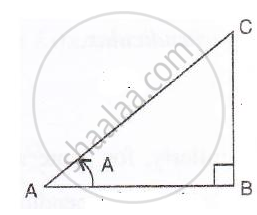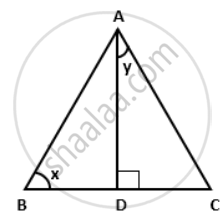Advertisements
Advertisements
प्रश्न
If sin A = `(sqrt3)/(2)` and cos B = `(sqrt3)/(2)` , find the value of : `(tan"A" – tan"B")/(1+tan"A" tan"B")`
उत्तर
Consider the diagram below : 'in A = `(sqrt3)/(2)`
'in A = `(sqrt3)/(2)`
i.e.`"perpendicular"/"hypotenuse" = (sqrt3)/(2) ⇒"BC"/"AC" = (sqrt3)/(2)`
Therefore if length of BC = `sqrt3x`, length of AC = 2x
Since
AB2 + BC2 = AC2 ...[ Using Pythagoras Therorm]
`(sqrt3x)^2 + AB^2 = (2x)^2`
AB2 = x2
∴ AB = x (base)
Consider the diagram below :
cos B = `(sqrt3)/(2)`
i.e.`"base"/"perpendicular" = (sqrt3)/(2) ⇒ "AB"/"BC" = (sqrt3)/(2)`
Therefore if length of AB = `sqrt3x` , length of BC = 2x
Since
AB2 + AC2 = BC2 ...[ Using Pythagoras Theorem ]
AC2 + `(sqrt3x)^2 = (2x)^2`
AC2 = x2
∴ AC = x(perpendicular)
Now
tan A = `"perpendicular"/"base" = (sqrt3x)/(x) = sqrt3`
tan B = `"perpendicular"/"base" = (x)/(sqrt3x) = 1/(sqrt3)`
Therefore
`(tan A – tan B)/(1 + tan A tan B) = (sqrt3 - 1/(sqrt3))/(1+sqrt3 1/(sqrt3)`
= `((2)/(sqrt3))/(2)`
= `(1)/(sqrt3)`
APPEARS IN
संबंधित प्रश्न
If A = B = 60°, verify that sin (A − B) = sin A cos B − cos A sin B
If sec 2A = cosec (A – 42°) where 2A is an acute angle. Find the value of A.
If 3 cot θ 4 , show that`((1-tan^2theta))/((1+tan^2theta)) = (cos^2theta - sin^2theta)`
Evaluate:
`4/(cot^2 30^0) +1/(sin^2 30^0) -2 cos^2 45^0 - sin^2 0^0`
If A = 600 and B = 300, verify that:
cos (A + B) = cos A cos B - sin A sin B
If A = 600 and B = 300, verify that:
(iii) tan (A-B) = `(tan A-tanB)/(1+tan A tan B)`
In the diagram, given below, triangle ABC is right-angled at B and BD is perpendicular to AC.
Find:
(i) cos ∠DBC
(ii) cot ∠DBA

In the figure given below, ABC is an isosceles triangle with BC = 8 cm and AB = AC = 5 cm. Find:
(i) sin B
(ii) tan C
(iii) sin2 B + cos2B
(iv) tan C - cot B
In triangle ABC, ∠B = 90° and tan A = 0.75. If AC = 30 cm, find the lengths of AB and BC.
In the given figure, AD is the median on BC from A. If AD = 8 cm and BC = 12 cm, find the value of tan x. cot y
